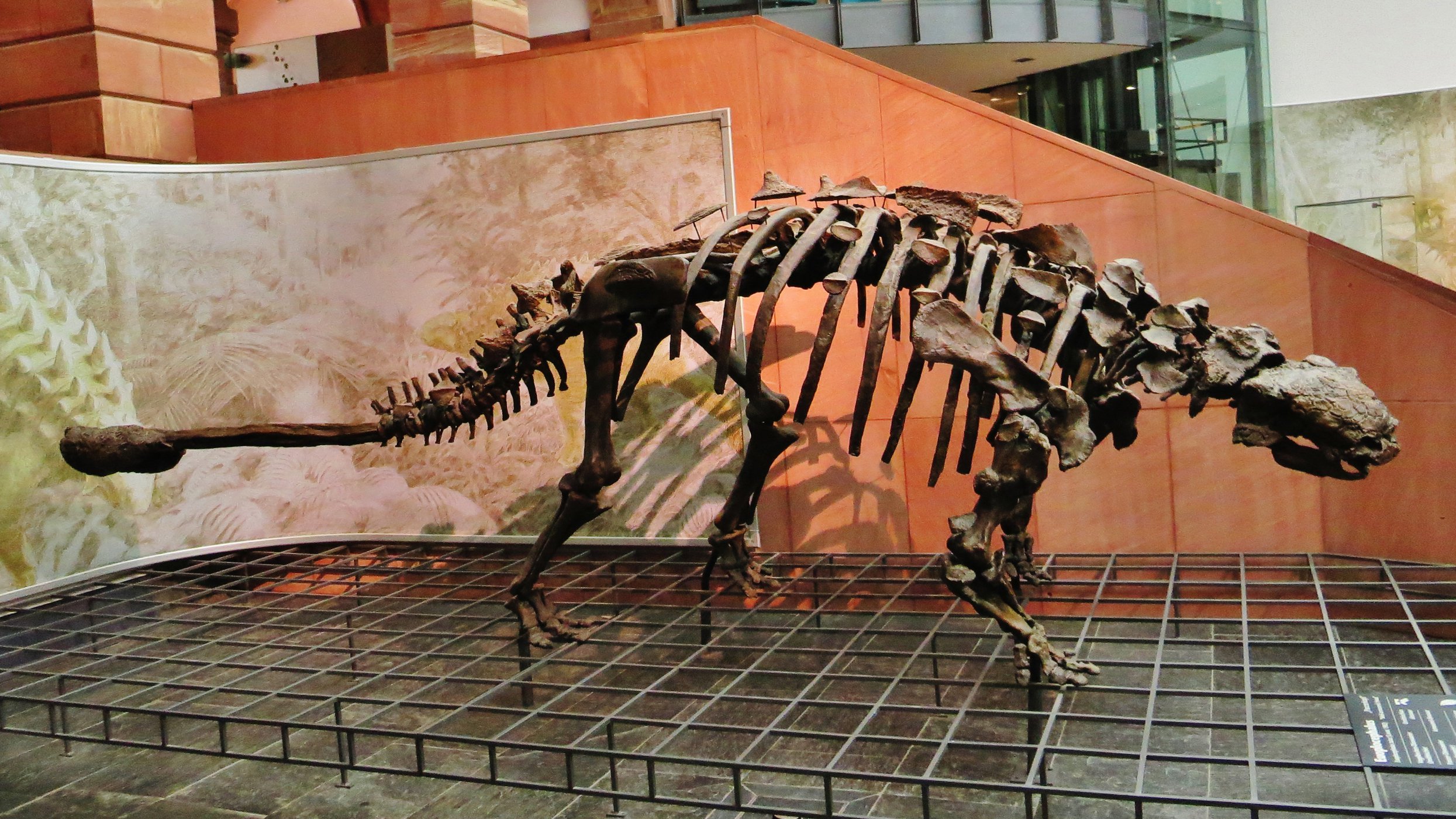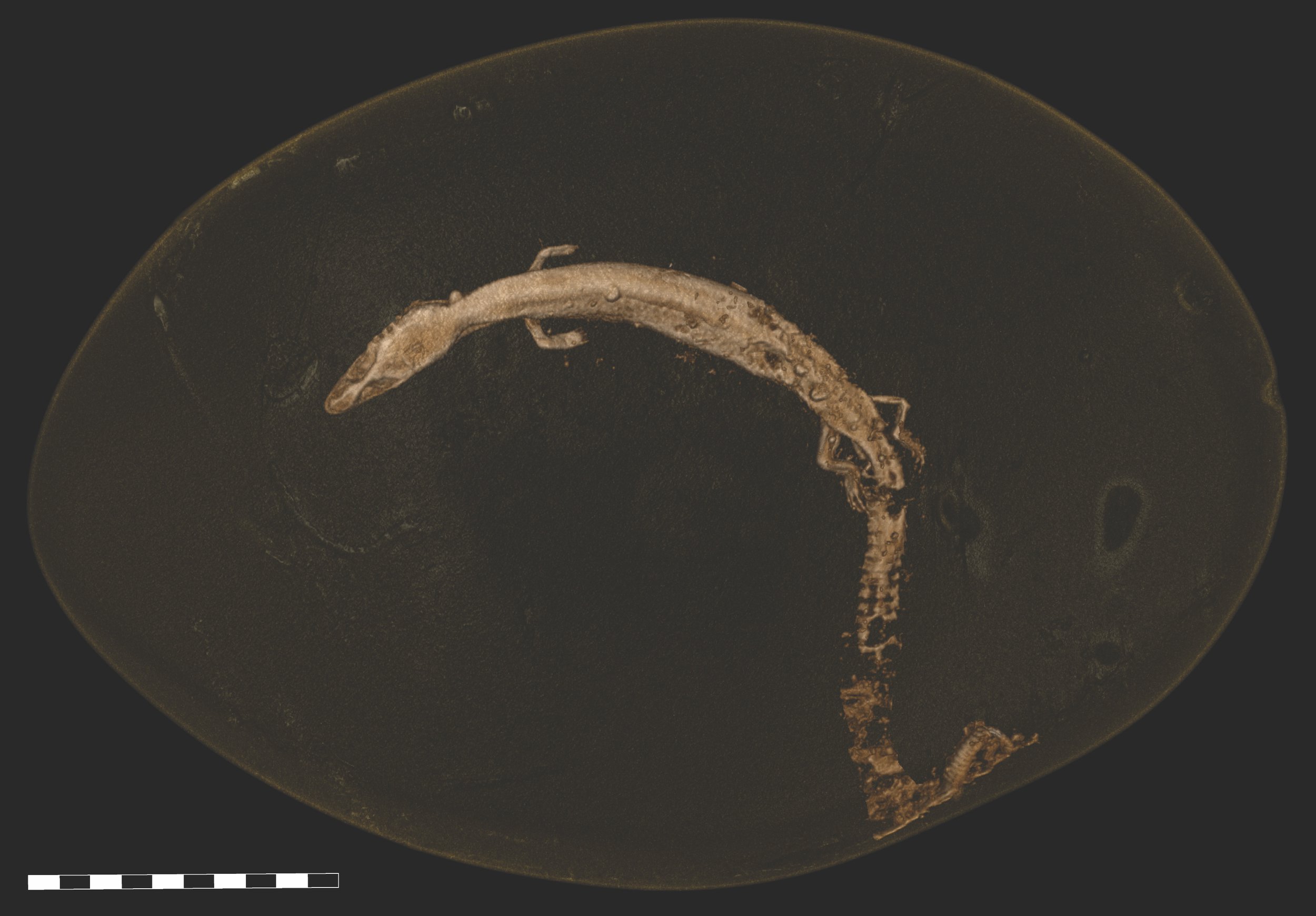These Dinosaurs Kept Cool With Krazy-Straw-Shaped Noses
Armored ankylosaurs like Panoplosaurus and Euoplocephalus had living air conditioners built into their noses, protecting their tiny brains from overheating.

Ankylosaurs like Euoplocephalus tutus harbored elaborate, convoluted nasal passages inside their armored skulls. Air flow through these twisted tubes kept the dinosaurs cool in the hot Cretaceous sun. Photo Credit: Ghedoghedo, Wikimedia Commons
With great size comes great responsibility—like the daunting task of cooling a tiny brain enclosed in a gigantic body. This problem likely plagued ancient ankylosaurs, a striking group of dinosaurs that, with their plated backsides and armored heads, resembled walking tanks roasting under the hot Cretaceous sun.
But these barrel-bodied behemoths might have had a clever solution to brave the heat. According to a new study published today in the journal PLOS ONE, the nasal passages of ankylosaurs were shaped like long, looping Krazy Straws, and functioned like living air conditioners. The cooling power of these convoluted coils likely kept their brains from overheating—and might have enabled ankylosaurs to grow to such large sizes in their toasty prehistoric climate.
“This represents a major step forward,” says Victoria Arbour, a paleontologist studying ankylosaurs at the Royal British Columbia Museum in Canada who did not participate in the new study. “The researchers have done a really exciting, thorough study with cutting-edge technology.”
For years, scientists have been aware of the mind-boggling twists and turns of ankylosaur nasal passages—“a crazy rollercoaster from nostril to throat,” says study author Jason Bourke, a vertebrate paleontologist at the New York Institute of Technology’s College of Osteopathic Medicine at Arkansas State. But why these creatures had such labyrinthine nasal cavities, which are notably absent in modern birds and mammals, including humans, remained elusive.
One possibility stuck out to Bourke and his graduate advisor, paleontologist Lawrence Witmer of Ohio University: a DIY dino cooling system. As herbivores, ankylosaurs might have spent a decent bit of time baking in the sun as they grazed on grass, which then likely fermented in their bellies, generating heat. Big bodies tend to hold on to warmth, meaning these leviathans might have struggled to keep delicate tissues, like their small brains, from cooking. Unless, that is, they had a built-in way to beat the heat.
Modern birds and mammals have handily solved this problem with bumps and whorls of tissue, or turbinates, in their relatively short nasal cavities. These protrusions increase the area onto which air flows, expanding the real estate for heat exchange within a small space. While some dinosaurs may have evolved turbinates, experts believe ankylosaurs weren’t among them. But a smooth nasal passage that stretched to great lengths might have created the same effect for these armored beasts.

Study authors Jason Bourke, Ruger Porter, and Lawrence Witmer with a set of ankylosaur skulls at Ohio University. Photo Credit: Lawrence Witmer Lab, Ohio University
Bourke knew testing the theory wouldn’t come easy. Part of the problem? “You can’t make a dinosaur breathe,” he says matter-of-factly, “because they’re all dead. That makes things more difficult.”
Soft tissues like noses and throats don’t fossilize, so when only the bones of an animal remain, puzzling through their physiology gets a little complicated. But among dinosaurs, ankylosaurs may be a particularly good candidate for study: Their cinder block heads seemed to be an asset in both life and death, pristinely preserving their skulls for millennia.
Using fossilized remains from two types of ankylosaurs—the hippo-sized Panoplosaurus mirus and rhino-sized Euoplocephalus tutus—Bourke and his colleagues first used CT scanning, an advanced form of x-ray-based imaging, to non-invasively visualize the insides of the dinosaurs’ skulls. They then used a computer program to simulate how heat and air would move through the nasal passages.
The approach required some degree of estimation to account for the missing soft tissues; to fill in the gaps, the researchers drew from known structures in well-studied modern creatures. “The fossils can speak for themselves, but not entirely,” Witmer explains. “We really needed info from animals around today.”
From start to finish, the ankylosaurs’ nasal rollercoasters promised quite the ride. The slightly more petite Panoplosaurus sported a 17-inch nasal passage—longer than its own skull. In Euoplocephalus, the cavity stretched out to about double this length. To fit inside the dinosaurs’ heads, these conduits had to coil into complex bundles. But when Bourke modeled the heat exchange occurring within, it was clear the jumbles were more than worth the trouble.
Both the ankylosaurs’ protracted nasal passages were extremely efficient at transferring body heat to incoming air, sometimes warming it by nearly 20 degrees Celsius (36 degrees Fahrenheit). This gave the dinosaurs a double dose of benefits: Their noses not only brought inhaled air closer to body temperature before it hit the lungs, but also sapped heat away from fragile organs. In keeping with this second function, the researchers found the dinosaurs’ skulls accommodated a large collection of blood vessels running from nose to brain. Presumably, it was through these avenues that heat was dumped into the nasal cavity.
Exhalation involved a similar process, only in reverse, returning moisture to the body as air meandered out the nose. A bit of warmth was also retained in the body, helping to conserve energy—though probably not enough to offset the cooling effects of inhalation on the brain, Bourke says.

The skulls of the two ankylosaurian dinosaurs—Panoplosaurus and Euoplocephalus—used in the study. The more elaborately coiled nasal passages of Euoplocephalus were more efficient than the simpler ones of Panoplosaurus. Photo Credit: Lawrence Witmer Lab, Ohio University
Bourke was amazed to find just how efficient these tortuous tunnels were: His analyses showed that ankylosaur nasal passages likely operated at a level on par with a turbinate-based system. To Bourke, this indicates that ankylosaurs and mammals independently found alternate solutions to the age-old problem of heat.
“This paper is one of the best projects on dinosaur physiology I’ve seen in a long time,” says Emma Schachner, who studies the evolution of the respiratory system at the Louisiana State University Health Sciences Center, but did not contribute to the new study. “This is the most rigorous way you can do these types of tests in extinct animals.”
But the ankylosaurs’ spiraling system had its drawbacks. These dinosaurs would have been unable to breathe very quickly: For heat exchange to occur in unembellished nasal passages, it’s critical that air moves somewhat slowly. Though, as Schachner points out, “stumpy” ankylosaurs weren’t much for galloping—especially given their heavy body armor. “They’re not agile, running animals,” she explains. “So perhaps keeping a lower respiratory rate wouldn’t be much of a problem.”
Next, the researchers hope to map the evolutionary origins of ankylosaurs’ serpentine sinuses. Though only two species have been surveyed so far, the larger Euoplocephalus hosts a more elaborate—and more efficient—nasal cavity than Panoplosaurus. If this trend is found in other ankylosaurs, or even other dinosaurs in general, it could lend support to the idea that bulkier bodies needed more circuitous noses to tolerate searing temperatures, says Matthew Vickaryous, an ankylosaur expert at the University of Guelph in Canada who did not contribute to the study.
“There’s more data in other species,” Vickaryous adds. “Ankylosaurs show a lot of differences in the size and shape of their skull, and the environments they inhabited. So I think we’re going to see a lot more diversity.”
And that diversity isn’t just limited to ankylosaurs. Several other dinosaurs may have come up with unique ways of keeping cool, explains Arbour, the Royal British Columbia Museum paleontologist. One example may have been the duck-billed hadrosaur (literally “large lizard”), which boasted atop its head a curved, backwards-facing crest that housed the creature’s nasal passages. Through whatever means, many dinosaurs may have literally sniffed their way to supersized stature.
Because so many dinosaur remains have been lost to time, paleontologists are likely just beginning to unravel the internal architecture of these mysterious animals. Even the most advanced models of dinosaur physiology pale in comparison to real flesh—not to mention the complex dynamics of active tissue in motion, says Nicole Xu, who studies the fluid mechanics of animal tissue at Stanford University, but was not involved in the new research. Future research may be able to incorporate some of these subtleties, Xu adds.
For now, the researchers’ new reconstructions have brought us closer to uncovering how dinosaurs dealt with the extremes of their environment—and may just breathe new life into creatures of a long-gone era. “The nose isn’t the flashiest part of any dinosaur,” Bourke says. “But it’s turning out to be a spyhole to look into their lives.”




